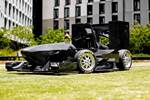Dynamic PRC racing team uses 3D printing to create DP13 autonomous race car
The new vehicle prototype uses fiber-reinforced 3D printing material formulated by the RadiciGroup to maximize mechanical and aesthetic performance.
The RadiciGroup (Gandino, Italy) Radilon Adline brand of 3D printing filaments — which include CS CF10 HP BK, a carbon fiber-reinforced polyamide product — is now part of the new single-seat racing car designed by the Politecnico di Milano (PoliMi, Milan) Dynamis PRC team. More than 100 engineering and design students worked on fine-tuning the 2022 electric model, which, for the first time, is also designed to work in self-driving mode.
Every year, the PoliMi racing team designs a new prototype Formula SAE car that competes in the international university engineering design championship. In the last two racing seasons, the Dynamis PRC team was reportedly ranked as the best Italian team and achieved excellent results at the international level.
“This year, the group decided to support the PoliMi university project, in keeping with the group’s [RadiciGroup’s] care for supporting young students (aged 19 to 25) who are committed to combine both their studies and extracurricular activities in the automotive sector, where RadiciGroup has great competence in materials and applications,” Angelo Radici, president of RadiciGroup, notes.
According to Chiara Devasini, marketing and development project leader of RadiciGroup High Performance Polymers, the company has been part of the automotive supply chain for more than 40 years. “We provide innumerable solutions that have been developed to meet demanding technical requirements and, in recent years, we have been particularly focusing on e-mobility,” Devasini says. “After a series of meetings concerning the young students’ needs for their new project, we thought of using one of the products in our Radilon Adline range specifically developed for additive manufacturing [AM]. These filaments are based on special polymer grades that have advanced technical characteristics, such as mechanical, chemical and thermal resistance, and are suitable not only for prototyping but also for manufacturing functional and structural components, as needed in this project.”
Using the RadiciGroup material, an engine cable support and flap ribs were printed for the race car. The support is needed to keep the engine cable in the correct position and becomes very fragile during sharp turns. The internal ribs are also said to be essential components for the structure and behavior of the carbon wing profile.
The PoliMi student formula team will compete in the Formula SAE championship throughout July and August, an international university competition with more than 15 global events and 600 participating universities.
Related Content
-
PEEK vs. PEKK vs. PAEK and continuous compression molding
Suppliers of thermoplastics and carbon fiber chime in regarding PEEK vs. PEKK, and now PAEK, as well as in-situ consolidation — the supply chain for thermoplastic tape composites continues to evolve.
-
3D-printed CFRP tools for serial production of composite landing flaps
GKN Aerospace Munich and CEAD develop printed tooling with short and continuous fiber that reduces cost and increases sustainability for composites production.
-
Large-format 3D printing enables toolless, rapid production for AUVs
Dive Technologies started by 3D printing prototypes of its composite autonomous underwater vehicles, but AM became the solution for customizable, toolless production.
















